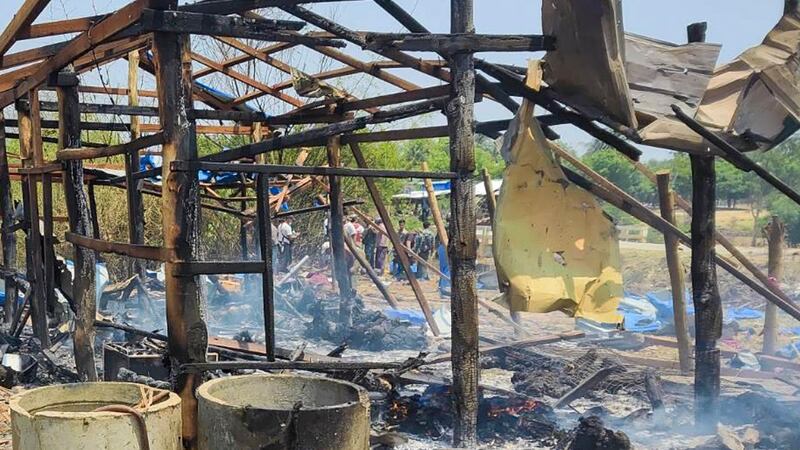[ Read RFA coverage of this story in BurmeseOpens in new window ]
Myanmar’s junta must allow greater aid access to civilians, the Red Cross chief said at the end of a visit to the war-torn country, warning that the conflict has created a humanitarian crisis that’s put “countless people” at risk.
The United Nations says about 3 million people have been forced from their homes by fighting between junta troops and those who oppose the military’s Feb. 1, 2024, coup d’etat, many since clashes surged at the beginning of the year.
The comments from International Committee of the Red Cross President Mirjana Spoljaric came as aid workers told RFA Burmese that 40,000 people had been displaced in central Myanmar’s Sagaing, Magway and Mandalay regions by junta airstrikes and troop raids between Aug. 1 and Sept. 10.
In a statement following her Sept. 5-9 trip, Spoljaric warned that a breakdown of healthcare services in Myanmar is leading to a rise in preventable diseases, while a lack of medical supplies is worsening the suffering of the wounded and chronically ill.
“Many families in Myanmar are going without basic medicines and health care, face food shortages and have limited access to clean water and sanitation. They live with the fear of conflict and violence,” she said in a statement. “The disruption of livelihoods is leaving countless people without the means to sustain themselves.”
Spoljaric noted that the military’s regular use of explosive weapons in populated areas has led to an increase in civilian casualties, while restrictions on the movement of people and goods has limited access to essential services for many communities.
During her visit, Spoljaric met with junta chief Senior General Min Aung Hlaing to discuss the ICRC’s goals in the country and urged him to allow greater access to conflict-affected areas – particularly in Shan, Kachin, Rakhine, Chin, Kayah, and Kayin states.
She also traveled to Rakhine state, where the military killed 70 people, including its troops in rebel captivity, in airstrikes on Sunday and Monday.
International humanitarian organizations have been helping civilians displaced by fighting in the region but most groups have withdrawn staff and suspended their work as the security situation has deteriorated.
Spoljaric said that the ICRC is engaging in dialogue with all stakeholders in the conflict “to remind them of their obligation to respect international humanitarian law and ensure the safety of civilians and humanitarian actors.”
Airstrikes displace 40,000
On Tuesday, residents and relief workers told RFA that junta troops had resumed offensives against villages in Sagaing, Magway and Mandalay regions, and that the air force is carrying out bombardments more frequently there.
RELATED STORIES
[ Myanmar junta airstrikes kill dozens, including prisoners, rebels sayOpens in new window ]
[ Rebel army captures major Myanmar navy training baseOpens in new window ]
[ Myanmar junta airstrike kills 11 civilians in northern townOpens in new window ]
A resident of Su Yit Kone village, in Mandalay’s Natogyi township, told RFA that nearly everyone had fled into the jungle because of the threat of airstrikes.
“The junta is intentionally destroying local houses every day to make the people afraid,” said the resident who, like others interviewed for this story, declined to be named due to security risks. “The villages aren’t active anymore. When it becomes dark, everyone beds down in the jungle.”
In Pa Zi Gyi village, in Sagaing region's Kanbalu township, residents have been sheltering in the jungle since April 2023, when a junta airstrike killed more than 170 people and leveled all but three of the village's 400 homes.

With airstrikes on the rise in the region, “we still don’t dare go back home,” one resident said, adding that junta planes are “constantly seen flying overhead.”
“Our village has turned into a wilderness,” he said. “We survive on collecting herbs and vegetables from the forest.”
The resident said that the displaced are only occasionally visited by small charity groups, who help supplement their food supplies.
Central region under assault
Meanwhile, junta ground forces are also stepping up raids on villages in the region.
On Tuesday, Data For Myanmar, which monitors arson attacks in Myanmar, reported that junta troops razed more than 1,043 houses in Sagaing, Magway and Mandalay regions in the first half of 2024 alone.
Attempts by RFA to contact junta spokesperson Major Gen. Zaw Min Tun about the reasons for the uptick in attacks in central Myanmar went unanswered Tuesday.
An official with the insurgent People’s Defense Force in Mandalay said that the junta sees central Myanmar as a militarily strategic region because it connects northern Shan, Kachin and Chin states to the rest of the nation.
"The people of central Myanmar have suffered a lot from the fighting, but they will persevere,” he said. “Victory by the armed opposition could present huge challenges to the junta because of the region’s strategic value, which is likely why the military is making a push there.”
Translated by Aung Naing. Edited by Joshua Lipes and Malcolm Foster.
